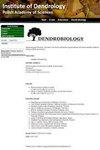长期分层和遮荫对孟氏假蝇幼苗出苗的影响
IF 1.8
4区 农林科学
Q2 FORESTRY
引用次数: 0
摘要
花旗松自19世纪中期开始在欧洲种植,但其人工再生导致幼苗产量低。通过延长播前处理(种子冷分层)或提前遮荫等措施对其进行改良,分析了它们对5个花旗松种子批的影响及其出苗和幼苗生长的影响。其中一批来自美国;四批来自捷克共和国。对未经预播处理的种子和分层21天和49天后的种子的发芽能力和发芽率进行了分析。对21天和49天分层(遮荫和不遮荫处理)以及秋播(不遮荫的处理)的变异株的出苗率进行了测试。结果表明,经过21天的分层处理,全种子的发芽能力达到最大。延长49天的分层提高了发芽率,尤其是在活力较低的种子地段。就地上部分的长度和生物量以及根系的生物量而言,最大的幼苗来自秋季播种的种子。春播后49天种子分层与遮荫3周相结合,可加速出苗,提高出苗率;幼苗获得了更多的生物量和地上部分的长度,与未遮蔽的幼苗或从21天分层种子中产生的幼苗相比,根系。秋播取得了相当或更好的效果。本文章由计算机程序翻译,如有差异,请以英文原文为准。
The effect of prolonged stratification and shading on the emergence of Pseudotsuga menziesii (Mirb.) Franco seedlings
The Douglas fir has been cultivated in Europe since the mid-19th century, but its artificial regeneration leads to a low yield of seedlings. It could be improved by prolonged pre-sowing treatment (cold stratification of seeds) or the early shading of sowings, so that their effect on five Douglas fir seed lots and their emergence and growth of seedlings were analysed. One lot came from the USA; four lots came from the Czech Republic. The germination capacity and germination rate were analysed for seed without pre-sowing treatment and seed after 21-day and 49-day stratification. The emergence rate was tested for variants of the 21-day and the 49-day stratification (shaded and unshaded treatment) and for autumn sowing (unshaded treatment). The results show that the maximal germination capacity of full seeds is achieved after the 21-day stratification. The prolonged 49-day stratification increases the germination rate, especially in seed lots with lower vitality. The biggest seedlings, in terms of length and biomass of the above-ground part and the biomass of the root system, emerged from seeds sown in autumn. The combination of the 49-day stratification of seeds and the 3-week shading after spring sowing can accelerate seedling emergence and increase the emergence rate of seedlings; seedlings achieve more biomass and length of the above-ground part, the root system compared to unshaded seedlings or seedlings emerged from 21-day stratified seeds. Comparable or better results were achieved from autumn sowing.
求助全文
通过发布文献求助,成功后即可免费获取论文全文。
去求助
来源期刊

Dendrobiology
农林科学-林学
CiteScore
2.20
自引率
11.10%
发文量
17
审稿时长
>12 weeks
期刊介绍:
Dendrobiology publishes original research articles and review articles related to the biology of trees and shrubs.
 求助内容:
求助内容: 应助结果提醒方式:
应助结果提醒方式:


